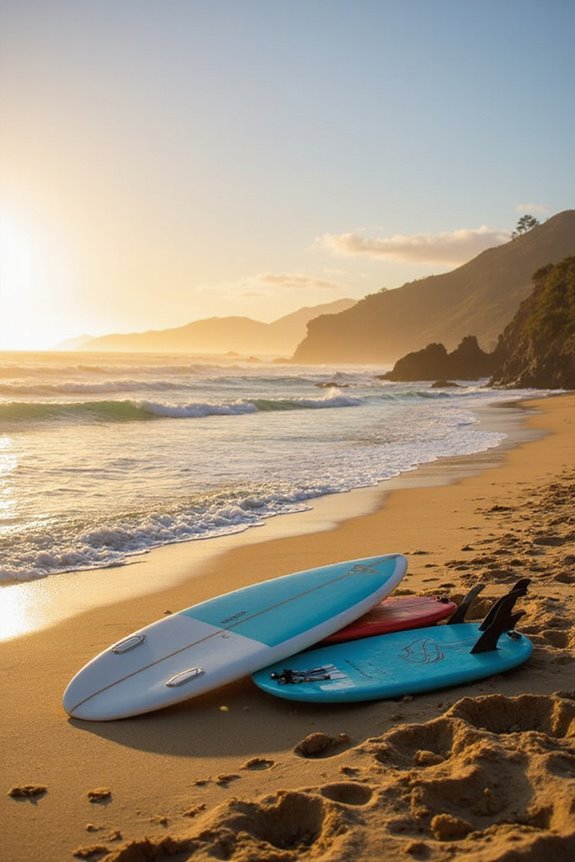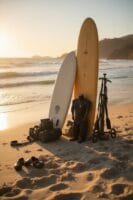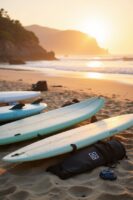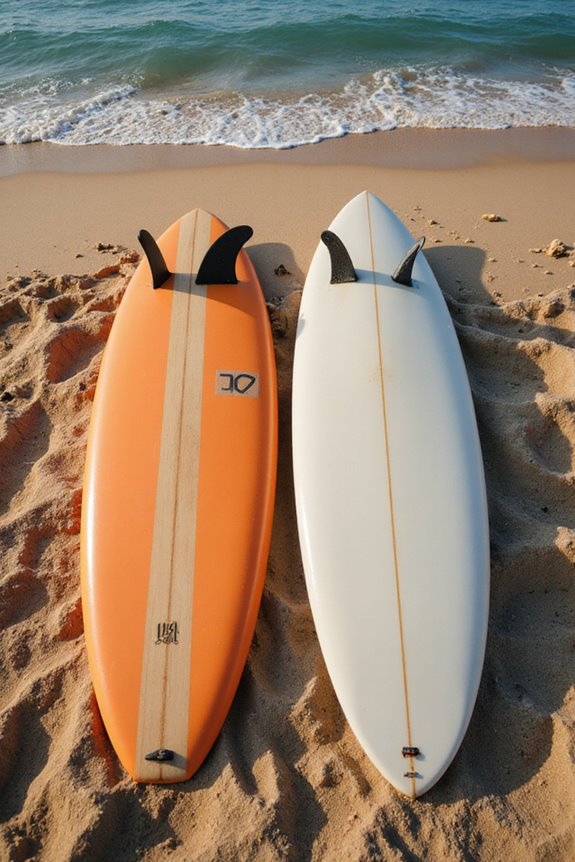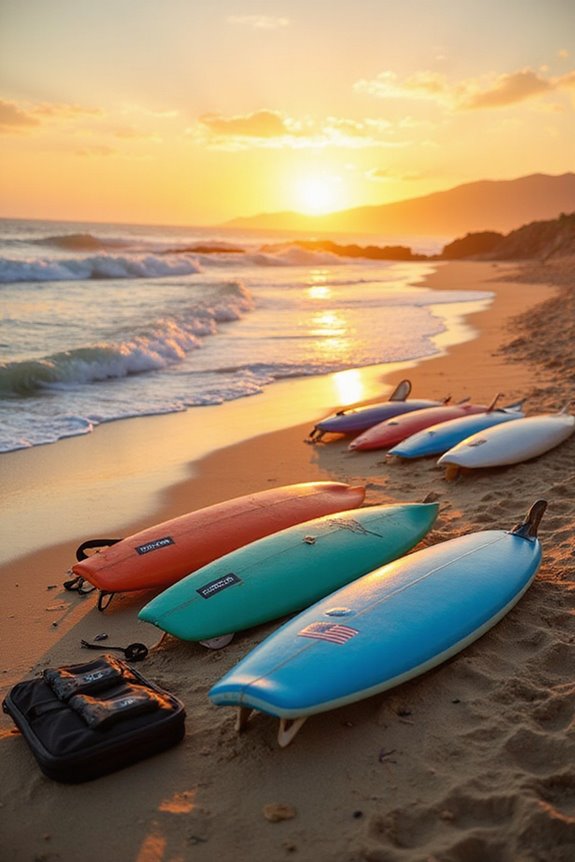To pop up on a surfboard, we should start by lying flat on the board with our body straight and hands near our lower chest. We’ll push our upper body off the board, then slide the back foot forward, placing it just ahead of the fins. Next, we should bring our front foot under our chest, landing it flat and centered over the stringer. Mastering timing and balance will enhance our wave-riding skills, and there’s more to explore.
Key Takeaways
- Lie flat on the surfboard with your body straight and hands positioned near your lower chest for maximum leverage.
- Push your upper body off the board to create room for your feet, maintaining a slight back arch for lift.
- Bring your back foot forward first, positioning it just ahead of the fins, then slide your front foot under your chest.
- Ensure your front foot lands flat and centered over the stringer, directly beneath your hands for balance.
- Practice timing your pop-up with the wave’s crest and listen for sound cues to enhance your coordination.
Understanding the Basics of the Pop-Up Technique
When learning to pop up on a surfboard, it is essential to grasp the fundamental steps involved in the technique. Understanding these pop up fundamentals sets the foundation for success.
- Start by lying flat on the board with your body straight, head facing the nose.
- Place your hands near your lower chest, fingers spread and relaxed.
- Push your upper body off the board, creating space for your foot placement.
- Bring your back foot forward first, positioning it just ahead of the fins.
- Slide your front foot under your chest, landing flat and centered on the stringer.
This technique breakdown emphasizes fluidity; each movement should flow into the next for an efficient pop-up. Practicing these steps will help develop muscle memory and improve performance, especially when paired with professional instruction to enhance your surfing skills.
Body Position and Balance During the Pop-Up
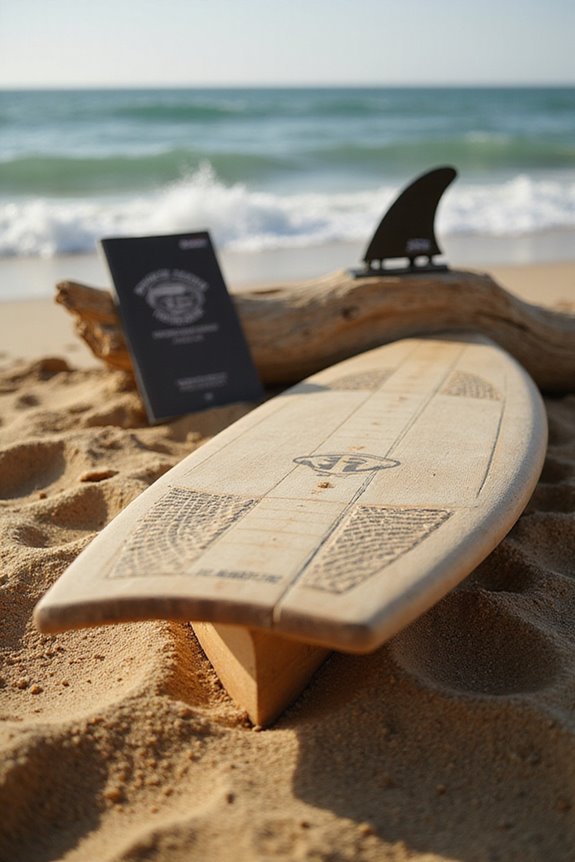
To achieve a successful pop-up, we need to emphasize proper body position and balance throughout the movement.
Hand Placement
We should place our hands close beside the chest to maximize pushing power. This positioning helps maintain balance and control as we lift our upper body off the board.
Body Alignment
A slight arch in our back prepares us for an efficient lift. Engaging our core is essential for controlling body alignment and maintaining balance once we’re upright.
Foot Placement
When swinging our legs forward, the front foot should land straight over the stringer, centered between our hands. This stabilizes us and guarantees we maintain balance while standing. Additionally, ensuring the right board size is crucial for beginners to aid in balance and stability during the pop-up process.
Exploring Pop-Up Variations for Different Skill Levels
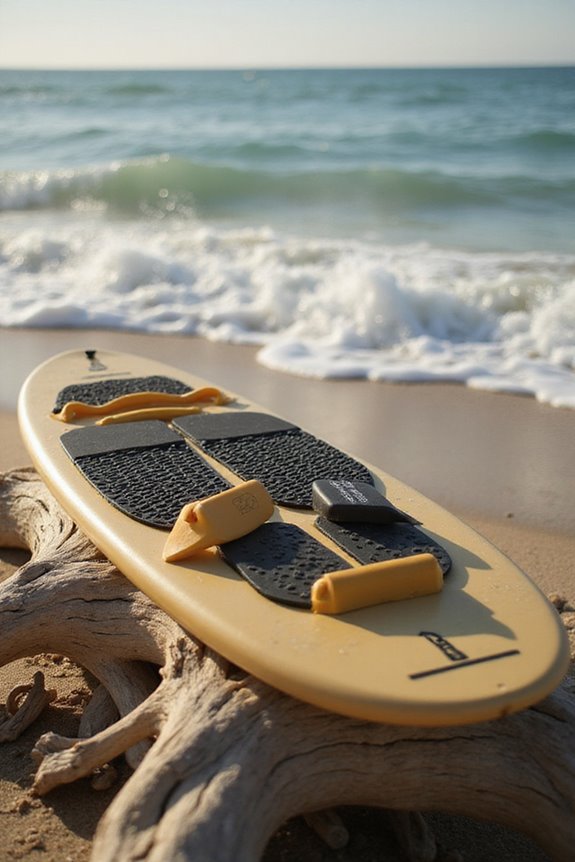
As we progress in our surfing journey, understanding the various pop-up techniques suited for different skill levels becomes essential.
Beginner Techniques
- Knees Technique: Ideal for complete beginners; it involves moving from prone to knees first, then standing up.
- Push Up: A multi-step approach for longboarders, emphasizing arm strength and gradual movement.
Intermediate Technique
– Aussie Method: This technique requires upper body strength and allows quicker shifts on shorter boards, balancing speed and control.
Advanced Technique
– Pro Pop: The fastest method, it involves an explosive movement to land both feet simultaneously on the board, enhancing performance on critical waves. This technique is particularly effective when used with shortboards designed for speed, maximizing your ability to catch and ride challenging waves.
Building Core Strength and Mobility for Effective Pop-Ups
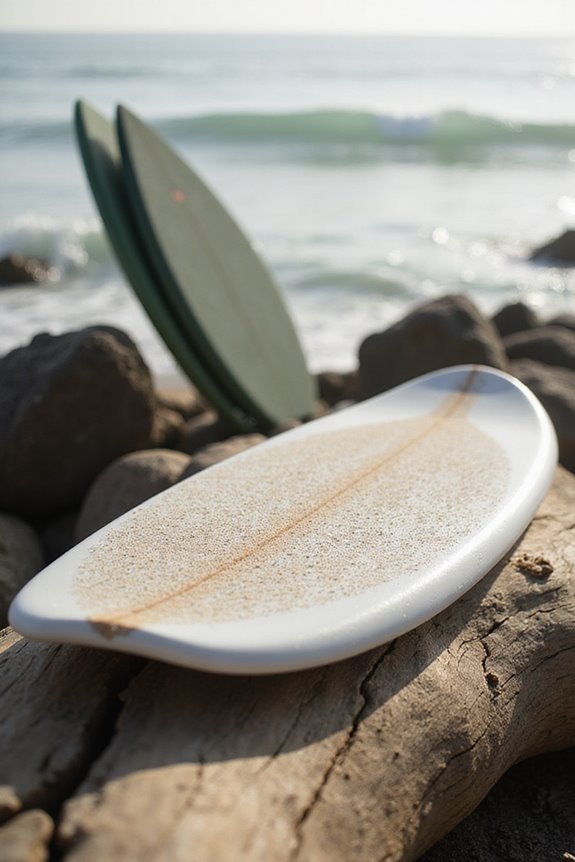
Building core strength and mobility is essential for effective pop-ups, as these elements directly influence our ability to shift smoothly from lying down to standing on the surfboard. Core stability is crucial for balance on the surfboard, enabling us to engage our muscles effectively during the changeover.
To enhance our pop-up skills, we should incorporate the following:
- Strength Training: Focus on exercises like plank variations and push-ups to build upper body and core strength.
- Mobility Exercises: Shoulder and hip mobility drills improve our range of motion and help prevent injuries.
- Dynamic Movements: Engage in squat-type exercises for endurance building and to facilitate smooth changeovers. Additionally, incorporating core strengthening workouts will further support our overall balance and control on the board.
Integrating these routines will enhance our performance and overall surfing experience.
Timing and Coordination for Successful Wave Riding
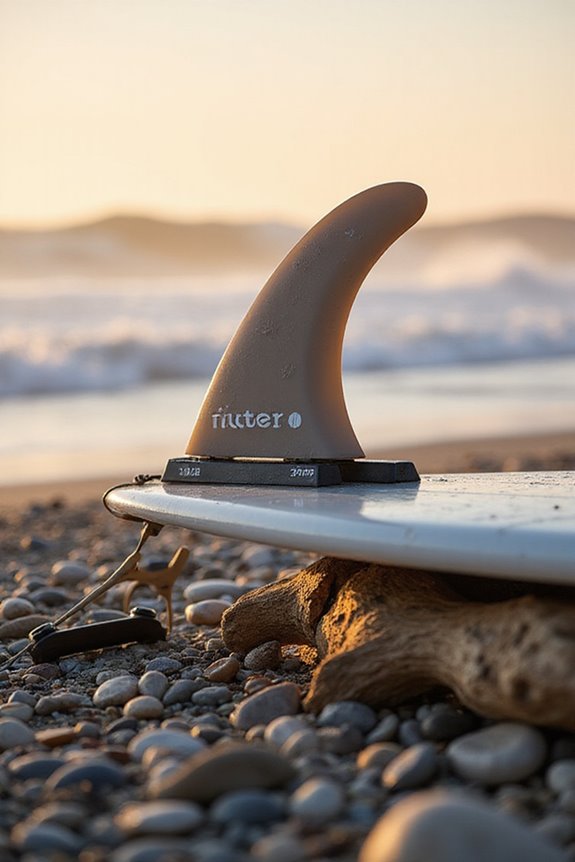
When we’re out on the water, mastering the timing and coordination of our pop-up is essential for effective wave riding. We need to recognize the ideal wave phase, executing our pop-up in the top third of the wave to maintain speed and control. Listening for auditory cues, like the “swishing” sound on our board, helps signal the right moment to pop up.
Visual awareness of the wave’s crest is vital, allowing us to judge when to shift from paddling to standing. By coordinating our body movements, such as lowering our hips and swinging our legs efficiently, we can align with the wave dynamics. This sensory feedback enhances our timing, leading to a smoother, more controlled ride. Additionally, choosing the right flexibility ratings for your fins can significantly impact your overall performance and control while popping up.
Practical Tips for Mastering the Pop-Up
Mastering the pop-up on a surfboard is essential for enhancing our performance in the water. To begin, our paddle positioning should be precise. We should place our hands flat near the ribcage, ensuring they’re shoulder-width apart for balance.
When it’s time to pop up, we need to focus on wave selection. As the wave gains speed, we should pop up quickly and smoothly. Bringing the back foot forward first, followed by the front foot, helps us maintain balance and control.
It’s vital to keep our eyes forward and body low while landing our feet. Additionally, understanding surf etiquette will ensure respectful interactions with other surfers while we practice our skills. Practicing this fluid motion will enable us to ride the waves with confidence and stability.
Training Approaches to Enhance Your Pop-Up Skills
Enhancing our pop-up skills involves a variety of targeted training approaches that improve our overall performance on the surfboard. We can incorporate explosive drills and balance exercises to develop strength and coordination.
Strength Training
- Perform push-ups on unstable surfaces to build upper body stability.
- Use weighted squats and lunges to enhance lower body strength.
Balance Conditioning
- Practice single-leg exercises to simulate the front foot position during a pop-up.
- Engage in dynamic balance exercises on gymnastics rings to mimic the surfboard’s instability.
Coordination and Technique
- Execute knee-to-opposite elbow touches for improved body coordination.
- Gradually progress from slow to fast pop-ups to build muscle memory.
Frequently Asked Questions
What Type of Surfboard Is Best for Beginners to Practice Popping Up?
Did you know that 70% of beginners find longboards easier to balance on? We recommend starting with a soft top longboard; its stability and safety make practicing popping up both fun and effective for new surfers.
How Long Does It Typically Take to Master the Pop-Up Technique?
Mastering the pop-up technique usually takes several weeks. Focusing on pop-up timing and incorporating practice tips like land drills can really speed up our progress, helping us gain confidence and balance on the board.
Can I Pop up Without Prior Surfing Experience?
Like learning to ride a bike, we can pop up without prior surfing experience. By mastering surfing fundamentals and practicing beginner tips, we build confidence and balance, transforming our initial wobbles into seamless rides on the waves.
Are There Any Common Mistakes to Avoid During the Pop-Up?
When we’re learning to pop up, we should watch out for timing mistakes and stance errors. Focusing on our foot placement and timing can help us ride more confidently and avoid frustrating wipeouts.
Should I Wear a Wetsuit While Practicing My Pop-Up?
We should definitely consider wearing a wetsuit while practicing our pop-up. It offers warmth and buoyancy, especially in cooler temperatures, enhancing comfort and confidence as we refine our technique in the water.

